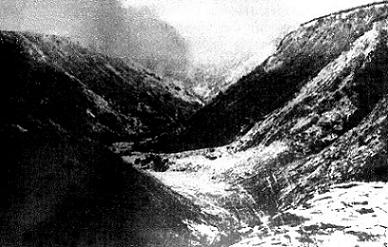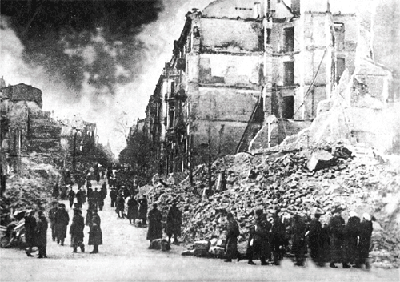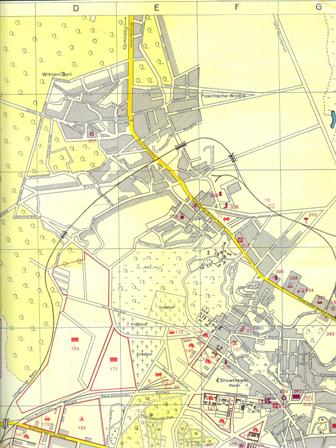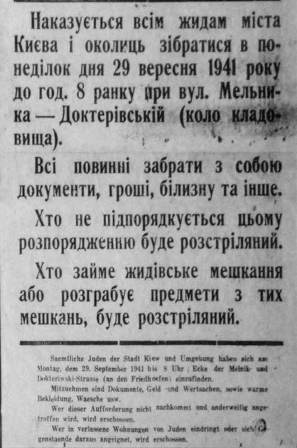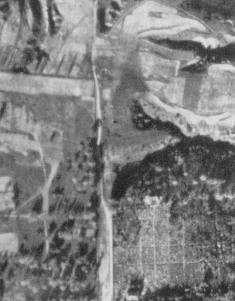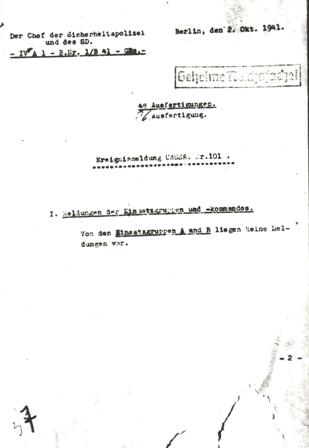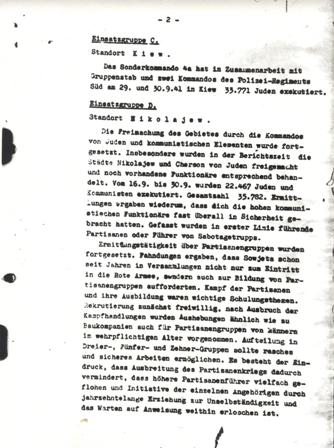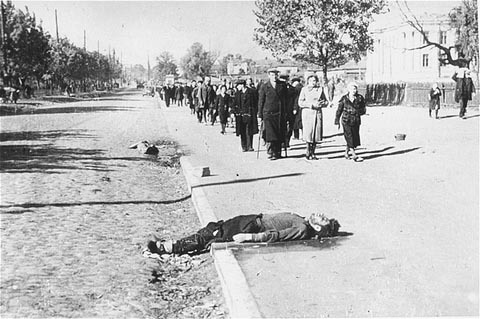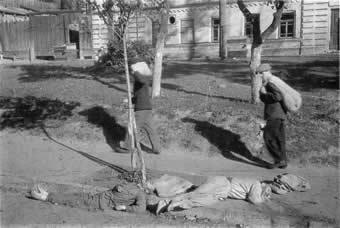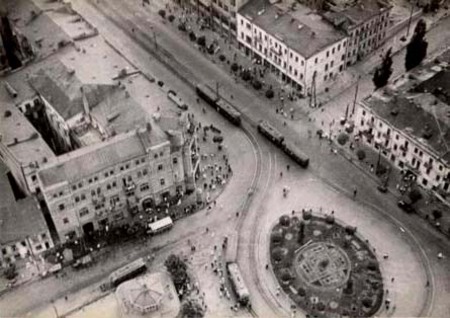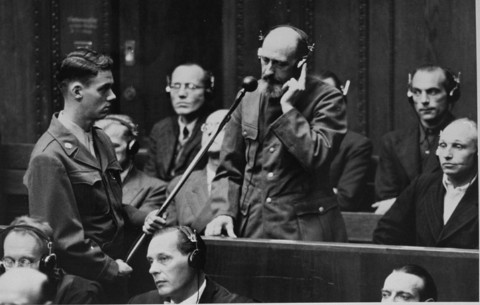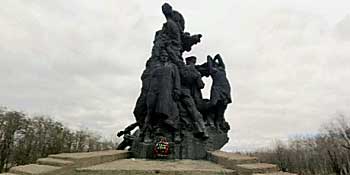Holocaust Education & Archive Research Team |
|
Einsatzgrϋppen
Einsatz Group A Einsatz Group B Einsatz Group C Einsatz Group D Babi Yar Articles Einsatz Leaders Einsatzgruppen Operational Situational Reports [ OSR's #8 - #195 ]
| |||||||
Babi Yar Mass Murder in Kiev
On 19 September 1941 the German XXIXth German Army Corps and the 6th Army entered Kiev, after a stiff Soviet defence that had lasted forty five days. Over 875,000 people lived in the city, of whom 20 percent were Jews (175,000). Some factories important for military purposes and their workers, among them approximately 20,000-30,000 Jews were evacuated by the Soviets. The exact number of evacuated Jews is unknown since no count was taken at that time. Perhaps 130,000 Jews fell into Nazi hands.
The population remembered the last German occupation in 1918 and were convinced that the occupiers would act in a civilized manner. It was anticipated that the Germans would restore the rights and property of the populace abolished by the Soviets.
The citizens of Kiev were not aware of the risks involved in falling into German hands, and could not imagine their ultimate fate. Jews had already been persecuted and killed during the first days of the occupation. However, for reasons still unknown, a ghetto was not established in Kiev.
On 24 September 1941, and in the following days, several bombs were detonated in Kiev (Kreshchatik and Prorizna Streets), and destroyed some buildings in the centre of the town, including the army headquarters and the Hotel Continental, where German officers resided.
Hundreds of German soldiers and officers were killed. The resulting fire also destroyed some further buildings. These bombs had been placed by a special command of NKVD agents who intentionally remained in Kiev for this purpose.
Alfred Jodl Chief of the Operations Staff of the High Command of the Armed Forces testified at his trial in Nuremberg: "hardly had we occupied the city when one tremendous explosion after another occurred. The major part of the inner city burned down, 50,000 people were made homeless. German soldiers were used to fight the flames, and suffered considerable losses, because further large amounts of explosives detonated during the fire... At first, the local commander in Kiev thought that it was sabotage on the part of the population, but then we found a demolition chart, which had already been prepared a long time ago, listing 50 or 60 objectives in Kiev for destruction.
This chart was, in fact, correct, as investigation by engineers at once proved. At least 40 more objectives were ready to be blown up; for the most part, remote control was to set off the explosion by means of radio waves. I myself had the original of this demolition chart in my hands."
German troops caught and executed a Jew on Kreshchatik Street, when he cut a water hose that was being used for fighting the fire. That may have been the excuse the Germans needed to accuse the Kiev Jews of being responsible for the explosions.
The German military commander of Kiev Generalmajor Eberhardt, attended a meeting with the Höherer SS- und Polizeiführer SS-Obergruppenführer Friedrich Jeckeln, the commanding officer of Einsatzgruppe C, SS-Brigadeführer Dr Otto Rasch, and the commanding officer of Sonderkommando 4a, SS-Standartenführer Paul Blobel.
They decided that the appropriate response to this sabotage should be the elimination of all Jews in Kiev, carried out by Sonderkommando 4a, consisting of SD and Sipo members, the 3rd company of the Waffen-SS Batallion zur besonderen Verfügung, and a platoon of the 9. Polizeibatallion. In addition Police Battalions 45 and 305 of the Polizeiregiment Süd and some Ukrainian auxiliary police troops would reinforce this murder squad.
A large ravine, called Babi Yar was chosen as the killing site. This ravine was located at the edge of Kiev, around 10 km northwest of the centre of the city, beyond the Lukyanovka Jewish cemetery. Today Babi Yar lies within the city precincts. On 26 September 1941 the German 637th propaganda company issued an announcement throughout Kiev published by the printing office of the 6th Army, ordering the Jews to report within the next three days at Lukianovska, Degtiarska, Lagerna, and Melnikova Streets.
_____________________________________________________________________
The announcement read:
"All Jews living in the city of Kiev and its vicinity must come to the corner of Melnikova and Dokhturovska* Street. (* misspelled version of Dokhturova Street / today Degtiarivska Street) (near the cemeteries) by 8 o'clock on the morning of Monday, September 29th 1941.
Thousands of Jews followed this order. In addition, to reinforce the propaganda, the Germans spread rumours that the Jews would be resettled to labour camps. Since the assembling point was situated near the goods station Lukianovska (today Lukianivka), most Jews believed the rumours. Guarded by SS, SD and Ukrainian auxiliaries, the Jews were marched in groups of 100 via the Melnikova Street to the Jewish cemetery located near the ravine called "Babi Yar". The entire surroundings of the ravine had been fenced in with barbed wire, and were cordoned off by three rows of troops: The outer circle was manned by Ukrainian police, the second with Ukrainian police and Germans, and the inner circle with Germans only.
At the killing site the Jews were ordered to undress, stack their belongings, and were then led in groups of 10 to the edge of the ravine. There they were shot (by automatic guns and machine-guns) in front of their fellow sufferers, who were unable to escape.
The witness Iryna Khoroshunova, resident of Kiev, stated in her diary entry for 29 September 1941:
Some people say the Jews are being shot with machine guns, all of them. Others say that 16 train wagons have been prepared and that they will be sent away. Where to? Nobody knows.
Only one thing seems clear: all their documents, things, and food are confiscated. Then they are chased into Babi Yar and there... I don't know. I only know one thing: there is something terrible, horrible going on, something inconceivable, which cannot be understood, grasped or explained."
By 2 October 1941 all doubts had disappeared: "Everybody is saying now that the Jews are being murdered. No, they have been murdered already. All of them, without exception - old people, women and children. Those who went home on Monday (29 September) have also been shot.
People say it in a way that does not leave any doubt. No trains left Lukianovska cemetery at all. People saw cars with warm shawls and other things driving away from the cemetery. German "accuracy". They already sorted the loot!
A Russian girl accompanied her girlfriend to the cemetery, but crawled through the fence from the other side. She saw how naked people were taken toward Babi Yar and heard shots from a machine gun. There are more and more rumours and accounts. They are too monstrous to believe. But we are forced to believe them, for the shooting of the Jews is a fact.
A fact which is starting to drive us insane. It is impossible to live with this knowledge. The women around us are crying. And we? We also cried on 29 September, when we thought they were taken to a concentration camp. But now? Can we really cry? I am writing, but my hair is standing on end."
More people than expected were brought to the site. According to a report from Einsatzgruppe C:
The historian Felix Levitas wrote:
"The executioners did not have enough time to finish their job. Therefore they began to put two people together, head by head, so that one bullet would kill two people. The wounded people were killed with shovels. The children were thrown into the Yar alive and buried with them."
"They shot people from morning to night. At night the Germans went to sleep. The rest of the victims were locked in empty garages. This continued for five days. The Nazis brought more and more people, and from there only trucks with people's clothes returned."
The mass murder of Jews in Kiev lasted until 3 October 1941. During the following months the ravine continued to be used as a killing site for Jews, Ukrainian civilians, Soviet POWs and Roma and Sinti.
According to Soviet sources 100,000-200,000 people were shot at Babi Yar up until the time that the area was liberated by the Red Army on 6 November 1943.
According to the "Operations Situation Report of Einsatzgruppe C" of 7 October 1941, the Germans claimed that 33,771 Jews had been shot in Kiev on the 29 and 30 September 1941.
Some Ukrainian inhabitants denounced their Jewish neighbours, others offered hiding places. After the war the Sipo and SD chief stated that his office in Kiev received baskets-full of denunciations from Ukrainian citizens. His office had insufficient time to deal with all of this information.
In March 1942 Albert Hartel, a Gestapo expert on church affairs was driving with Blobel towards a country villa outside Kiev, used by Gruppenfuhrer Max Thomas the Higher SS and Police Leader. At the Babi Yar ravine, Hartel noticed small explosions, which threw up columns of earth.
It was the thaw releasing the gasses from thousands of bodies, and Blobel explained, “Here my Jews are buried.” In July 1943 Blobel came back to Kiev
Because of the approaching Red Army he was ordered to remove all traces of mass murder in the East. In the Kiev area his units were assisted by SS-Gruppenführer Max Thomas, commander of the SD and Sipo in the Ukraine. Blobel established three special units from his Aktion 1005 troops:
On or near 18 August the Sonderkommando 1005 A started to exhume and burn the corpses. This Sonderkommando consisted of 8 - 10 SD men and 30 German policemen, commanded by SS-Obersturmbannführer Baumann.
The Germans did not carry out this work themselves. 327 inmates of the nearby KZ Syrets (among them 100 Jews) were forced to undertake this horrible task. The prisoners completed this work within six weeks. Those sick or too slow were shot on the spot. A German Schupo witness:
Blobel, on 18 June 1947:
Afterwards the grave was filled in and all traces thereby virtually obliterated. Because of the advance of the front it was not possible to destroy the mass graves located in the South and East which had resulted from execution by the task groups."
The corpses were cremated on funeral pyres, built on iron rails. Firewood was stacked, then the corpses were placed on this petrol soaked material. When the pyres had burned down, the special command of prisoners had to collect the remaining bones which were pulverized with tombstones from the Jewish cemetery. Finally the ashes were inspected in order to collect any remaining silver and gold (these men were called "Goldsucher" ("Gold diggers").
On 29 September 15 prisoners of the Sonderkommando were able to escape; 312 of their comrades were finally killed by the SS either during or on completion of the work. In October 1944 the remaining troops of Aktion 1005 were ordered to Kärnten (Carinthia / Austria) to fight against Yugoslav partisans, under the name "Einsatzgruppe Iltis", commanded by Blobel
For political reasons an official memorial was not built at the site until 1976. The first memorial did not mention that most victims were Jews. It took a further 15 years before a new memorial (Menorah) was built which today serves as a place for commemorative ceremonies.
SS- Standartenfuhrer Paul Blobel was condemned to death at Nuremberg in 1948,he was executed at Landsberg on 8 June 1951.
Sources:
The Final Solution by G. Reitlinger –published by Vallentine Mitchell and Co 1953. Babi Yar – The Tradegy of Kiev’s Jews by Victoria Khiterer. Encyclopedia of the Holocaust, Macmillan Publishing Company, New York, 1990.
Copyright: 2007 SJ & CL H.E.A.R.T
|
